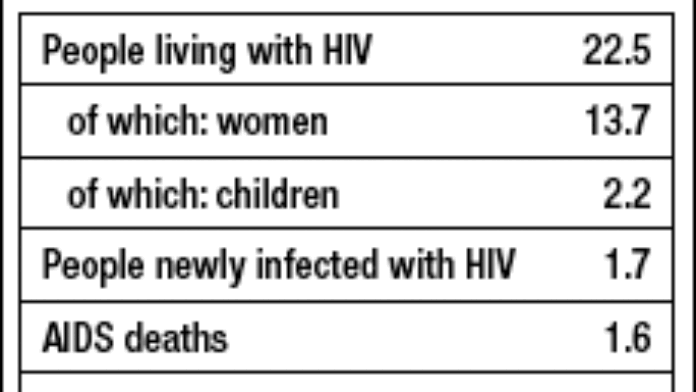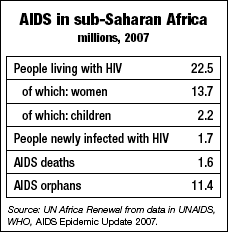
For the first time since the AIDS pandemic was identified a quarter-century ago, “we are seeing a decline in global AIDS deaths,” reports Dr. Kevin De Cock, director of AIDS at the World Health Organization (WHO). Revised figures released by WHO and the Joint UN Programme on HIV/AIDS (UNAIDS) also show that new infections from HIV, the virus that causes the disease, have begun to fall as well.
By Ernest Harsch
For the first time since the AIDS pandemic was identified a quarter-century ago, “we are seeing a decline in global AIDS deaths,” reports Dr. Kevin De Cock, director of AIDS at the World Health Organization (WHO). Revised figures released by WHO and the Joint UN Programme on HIV/AIDS (UNAIDS) also show that new infections from HIV, the virus that causes the disease, have begun to fall as well.
The revision generated considerable controversy, with some independent AIDS experts arguing that the data should have been adjusted earlier. But all agree that the newer, more accurate figures have brought into the open an important shift in the epidemic’s progression, one that was not apparent with the older statistics.
In adjusting their overall estimates retroactively, to previous years, the two UN institutions revealed some positive trends over time. First, new infections with HIV were likely to have peaked in the late 1990s, when more than 3 million people became newly infected annually. The revised estimates indicate that this total has actually been declining since then, to some 2.5 million newly infected in 2007. Second, the number of annual deaths from AIDS has also started to fall, from a high point of around 2.4 million in 2005 to about 2.1 million in 2007.
To an extent, these changing trends reflect some of the first significant successes in AIDS-prevention efforts. In a number of countries, according to national survey results, young people are engaging in less risky sexual behaviour, whether by using protective condoms or by having fewer or no partners. The report cites evidence of such behavioural changes in Botswana, Cameroon, Kenya, Malawi, Togo, Zambia, Zimbabwe and a few other countries.
‘Real nightmares’ in Africa
Neither the shift in the disease’s overall trend nor the revision in the estimates has changed one glaring fact: sub-Saharan Africa remains the epicentre of the global malady. Of all those living with HIV, about 22.5 million, or 68 per cent of the world’s total, are in sub-Saharan Africa. The region accounts for the same percentage of people newly infected with the virus, as well as 76 per cent of those who die of AIDS annually.

“AIDS continues to be the single largest cause of mortality in sub-Saharan Africa,” says the report. Moreover, in contrast to other world regions, women and children are far more vulnerable to the disease in sub-Saharan Africa. Of those Africans living with HIV, 61 per cent are women, while fully 90 per cent of all HIV-positive children in the world are in sub-Saharan Africa.
Within the continent, Southern Africa is by far the most afflicted, accounting for around a third of all new HIV infections globally and about a third of people living with HIV. In eight countries — Botswana, Lesotho, Mozambique, Namibia, South Africa, Swaziland, Zambia and Zimbabwe — national adult HIV-prevalence rates exceed 15 per cent. South Africa leads the world in the number of people infected with HIV.
Southern African countries, says Daniel Halperin, an AIDS expert at the US’s Harvard School of Public Health, are continuing to experience “real nightmares.” Whatever else the revision in the overall AIDS figures may show, he adds, “this doesn’t mean the epidemic is going away.”
Statistical refinements
In poor, largely rural countries with weak health systems and limited ability to collect data, measuring the extent of an infectious disease is always difficult, notes Dr. Paul De Lay, a UNAIDS director. “The challenge is equally true for TB, polio and childhood diarrhoea.”
In the case of HIV/AIDS, earlier estimates were based mainly on information collected on young women visiting public health clinics either because they were pregnant or because they feared they had been infected. Those results were then extrapolated to the rest of the population to come up with estimated national infection rates. But over time experts realized that data from urban clinics were skewed: they gave too much statistical weight to sex workers, drug users and people with multiple partners, relative to other sectors of the population.
As donor countries gradually began providing more funds to combat the disease, some of those resources were allocated for more scientifically designed national surveys, at a cost of $2–3 mn per country. Across the board, the surveys showed that the scale of the epidemic was somewhat less than previously thought.
According to UNAIDS, analyses of national survey results in India in July reduced estimates of the number of people living with HIV in that country by more than half, from 5.7 million people to 2.5 million, a revision that accounted for half of the decline in the global estimate. Much of the remaining adjustment, reports UNAIDS, came from revised estimates for several African countries, including Angola, Kenya, Mozambique, Nigeria and Zimbabwe.
Some independent AIDS researchers had been arguing for several years that the UN’s earlier estimates were too high, and complain that their arguments were ignored. A few charged that the figures were consciously exaggerated as part of a strategy to raise international alarm about the disease and prompt donors to release more funds. Dr. De Lay regards such accusations as “absurd.” It would be “technically impossible” for UNAIDS “to somehow rig the numbers,” he says, since they are gathered by national health ministries and reviewed by many experts inside and outside the UN system.
Many countries have not yet conducted national surveys, and for those that have, it is impractical to update the costly surveys every year. So while the surveys are now helping to produce better data, the figures reported by UNAIDS and WHO remain rough estimates. To demonstrate the continuing uncertainty, the Update report includes a range of low and high estimates with most of its baseline figures. For instance, the total of 33.2 million people living with HIV worldwide may actually be as low as 30.6 million — or as high as 36.1 million.
No time for complacency
Whether the numbers are going up or down, there should be no complacency, UNAIDS and other experts warn. There is still no cure for AIDS, Dr. De Lay points out. Moreover, in a number of countries that had previously made progress in reducing infection rates, but in which anti-AIDS programmes have diminished, “we are seeing a return of the epidemic,” he notes. The Update reports that prevalence rates are rising again in the US, the UK and Germany — as well as in Uganda, which once was hailed for its success in bringing down HIV rates. Nor should the international community slacken its own efforts, argue AIDS advocates. Current international spending, at around $10 bn annually, continues to fall short of actual needs. “There’s still a huge epidemic out there that still needs huge resources to win the battle,” says Paul Zeitz, executive director of the Global AIDS Alliance, an international non-governmental group headquartered in Washington, DC.
UNAIDS and WHO are planning to issue a report in 2008 on financing the global campaign against AIDS. It is possible, says Dr. De Lay, that projected treatment costs, such as for providing anti-retroviral medicines to people with full-blown AIDS, will be about 5 per cent less in 2010 than previously estimated. But that total will still be around $38 bn — far higher than current AIDS financing.
“We have to recognize the very long-term nature of the HIV pandemic,” says Dr. De Cock. “We’re facing decades of this problem.” Of those currently infected, “some of them require treatment now, and all of them will in time. The qualitative implications have changed very little.”
Photo: Peter Arnold Inc / Neil Cooper

